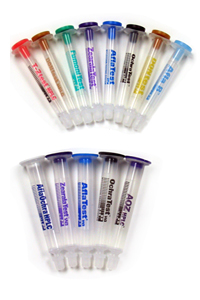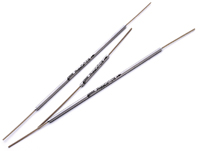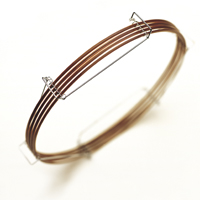
More about chromatography
forte CYDEX-B
 (Permethylated Beta Cyclodextrin)
(Permethylated Beta Cyclodextrin)
- Chiral column for the separation of enantiomeric compounds found in natural products.
Applications:
- Enantiomeric purity
- Flavour
- Terpenoids
| ID (mm) | df(µm) | Temperature limits (°C) |
|---|---|---|
| 0.22 | 0.25 | 30 to 220/240 |
| 0.25 | 0.25 | 30 to 220/240 |
Chromatography links
 Library4Science has been established to bring technical reference and educational resources for chromatography to the internet. The site includes principles and practice of chromatography. You also can download various resources in pdf.
Library4Science has been established to bring technical reference and educational resources for chromatography to the internet. The site includes principles and practice of chromatography. You also can download various resources in pdf.
- LC-GC Europe is the premier publication serving the separation science industry in Europe
- Published monthly
- Supplies troubleshooting information and application solutions on all aspects of sample preparation, chromatography, and capillary electrophoresis
ChemSpider is a free chemical structure database providing fast text and structure search access to over 100 million compounds from many data sources.
![]() International Environmental Technology
International Environmental Technology
- Journal promoting and introducing lates products for environmental applications
- IET card for fast information
- Free subscription for printed journal
Immuniafinity column materials
 Mycotoxins are toxic substances naturally produced by molds (fungi) that may contaminate agricultural commodities by growing on grain or feed. These molds result in a variety of dangerous mycotoxins, such as aflatoxin, fumonisin, deoxynivalenol (DON), ochratoxin, and zearalenone - some of which are known human carcinogens. The U.S. Food & Drug Administration (FDA) has determined acceptable levels of certain mycotoxins for consumption by humans and different species of animals. Furthermore, the European Union (EU) continues to tighten its regulations. This stiffening of EU import standards drives worldwide adoption of mycotoxin tests that are ever more precise, accurate, and sensitive.
Mycotoxins are toxic substances naturally produced by molds (fungi) that may contaminate agricultural commodities by growing on grain or feed. These molds result in a variety of dangerous mycotoxins, such as aflatoxin, fumonisin, deoxynivalenol (DON), ochratoxin, and zearalenone - some of which are known human carcinogens. The U.S. Food & Drug Administration (FDA) has determined acceptable levels of certain mycotoxins for consumption by humans and different species of animals. Furthermore, the European Union (EU) continues to tighten its regulations. This stiffening of EU import standards drives worldwide adoption of mycotoxin tests that are ever more precise, accurate, and sensitive.
One method of mycotoxin analysis includes sample extraction and clean-up with VICAM immunoaffinity columns, followed by high pressure liquid chromatography (HPLC). In addition to HPLC analysis, VICAM immunoaffinity columns can be used for the quantitative detection of mycotoxin present through the use of a fluorometer. The use of VICAM immunoaffinity columns with the aforementioned instruments can provide a reading of actual mycotoxin content over a range of contamination levels.
More information about products are available in the product catalogue. List of Official methods using Vicam immunoaffinity columns is available here.
Vicam Immunoafinity Columns
| Product Name | Mycotoxin of interest | Detection limit | Analytical Method | Note |
|---|---|---|---|---|
| Myco6in1™ | Aflatoxin B1 Aflatoxin B2 Aflatoxin G1 Aflatoxin G2 Ochratoxine A Fuminonisin B1 Fuminonisin B2 DON Zearalenone T2 Toxine HT-2 Toxine | 0.6 ppb 0.3 ppb 0.4 ppb 0.8 ppb 0.6 ppb 1.1 ppb 0.4 ppb 4.2 ppb 0.7 ppb 1.5 ppb 1.9 ppb | LC/MS/MS | Detection limits are dependent upon the detection system used. |
| Aflatest® | Aflatoxin B1 Aflatoxin B2 Aflatoxin G1 Aflatoxin G2 Aflatoxin M1 | from 0.1 ppb | Fluorometer or HPLC | |
| Aflatest® WB | Aflatoxin B1 Aflatoxin B2 Aflatoxin G1 Aflatoxin G2 Aflatoxin M1 | from 0.03 ppb | HPLC | 3 ml tube, fast-flow columns, wide range |
| Aflatest® WB SR | Aflatoxin B1 Aflatoxin B2 Aflatoxin G1 Aflatoxin G2 Aflatoxin M1 | HPLC | 3 ml Fast-flow widebore columns are specially designed to maximize aflatoxin G2 recovery and accelerate sample throughput . | |
| Afla B™ | Aflatoxin B1 Aflatoxin B2 | from 0.1ppb | Fluorometer or HPLC | |
| Afla M1FL™ | Aflatoxin M1 | 12.5 ppt* | Fluorometer | |
| Afla M1HPLC™ | Aflatoxin M1 | 10 ppt* | HPLC | |
| AflaOchra HPLC™ | Aflatoxin B1 Aflatoxin B2 Aflatoxin G1 Aflatoxin G2 Ochratoxin A | from 0.25 ppb | HPLC | |
| AOZ HPLC™ | Aflatoxin B1 Aflatoxin B2 Aflatoxin G1 Aflatoxin G2 Ochratoxin A Zearalenone | 0.1 ppb 0.1 ppb 0.1 ppb 0.1 ppb 0.25 ppb 5.0 ppb | HPLC | |
| CitriTest™ | Citrinin | 10 ppb | HPLC | |
| DONtest™FL+ | Deoxynivalenol (DON) | 0.5 ppm | Fluorometer | |
| DONtest HPLC™ | Deoxynivalenol (DON) | 0.1 ppm | HPLC | |
| DONtest™ WB | Deoxynivalenol (DON) | 40 ppb | HPLC | 3 ml tube, fast-flow columns, wide range |
| FumoniTets™ | Fumonisin B1 Fumonisin B2 Fumonisin B3 | 16 ppb | HPLC | |
| Fumonitest™ WB | Fumonisin B1 Fumonisin B2 Fumonisin B3 | 10 ppm | HPLC | 3 ml tube, fast-flow columns, wide range |
| FumoniTest200™ | Fumonisin B1 Fumonisin B2 Fumonisin B3 | 0.5 ppm | Fluorometer | |
| OchraTest™ | Ochratoxin A | 1 ppb | Fluorometr or HPLC | |
| Ochratest™ WB | Ochratoxin A | 0.25 ppb | HPLC | 3 ml tube, fast-flow columns, wide range |
| T-2test™ HPLC | T-2 toxin | 5.0 ppb | HPLC | |
| T-2/TH-2™ HPLC | T-2 toxin TH-2 toxin | HPLC | ||
| ZearalaTets™ | Zearalenone | 0.1 ppm | Flourometr or HPLC | |
| ZearalaTets™ WB | Zearalenone | 10 ppb | HPLC | 3 ml tube, fast-flow columns, wide range |
*ppt - parts per trillion
forte SolGel-WAX
 (Polyethylen glycol phase)
(Polyethylen glycol phase)
- High polarity phase.
- Unigue technology (SolGel material) - the phase is encapsulated in synthetic glass.
- Robust and high temperature WAX column.
Applications:
- Esentials oils
- Solvents
- BTEX
- FAMEs
- Alcohols, aldehydes, esters and ketones
| ID (mm) | df(µm) | Temperature limits (°C) |
|---|---|---|
| 0.25 | 0.25 | 30 to 280/300 |
| 0.25 | 1.00 | 30 to 280/300 |
| 0.32 | 0.25 | 30 to 280/300 |
| 0.32 | 0.50 | 30 to 280/300 |
| 0.53 | 0.50 | 30 to 280/300 |
| 0.53 | 1.00 | 30 to 280/300 |
ProteCol Phase
ProteCol - a revolution in Nano / Capillary LC
Incorporating columns, unions, tubing, splitters and filters, every component of ProteCol has been designedspecifically for Capillary LC. ProteCol can provide you with a complete Capillary LC solution, or individual components of ProteCol can be incorporated into your existing system.
- Performance Plus: The peak broadening effect of dead volume and total swept volume is much more significant in Capillary LC compared to conventional LC. The entire ProteCol range has been specifically designed as a 'zero dead volume' system to give you the highest possible resolution and efficiency, therefore maximizing the advantages of Capillary LC.
- Ease of Use: A key to the success of the ProteCol system is the ease with which zero dead volume connections can be made between columns, tubing and all accessories.
- Versatility: ProteCol columns, unions and accessories are designed to be used together as a complete system, or can be individually incorporated into your existing capillary LC setup.
- Flexibility: With a variety of columns, unions, and tubing sizes, ProteCol adapts to suit your own requirements.
 Nanovolume generally refers to components with bore sizes less than 250 µm (0.010''). The minimal transfer volume contributed by nanovolume components makes them especially beneficial with flow rates in the µL/min range, when the transfer volume can be critical.
Nanovolume generally refers to components with bore sizes less than 250 µm (0.010''). The minimal transfer volume contributed by nanovolume components makes them especially beneficial with flow rates in the µL/min range, when the transfer volume can be critical.
Maximum performance
The core of any separation system is the column. ProteCol columns are designed specifically for Nano and Capillary LC. The column body is integrated with the connection tubing, both of which are made from inert fused silica lined PEEK™ tubing, giving a robust and flexible column.
The connection tubing is available in 1/16" and 1/32" outer diameter, and is supplied with precisely square cut and polished ends for easy zero dead volume connections. To minimize post column broadening, ProteCol columns are supplied with a short 100mm outlet tail. ProteCol columns are available in a variety of lengths, ID's and packings.
The most commonly used packing material is C18 modified silica, 3μm particles, which offers a high resolution while allowing the use of shorter columns. Typical pore sizes are 120Å for small molecules (pharmaceutical drugs and small peptides) and 300Å for larger molecules (large peptides and small proteins). Ideal for applications in Proteomics and Drug Discovery.
More details about ProteCol products are available here.
forte BP1
(100% dimethyl polysiloxane)
- Low polariry phase.
- Equivavelent to USP G2 phases.
- An industry standard non-polar phase suitable for all routine analyses.
- An extremely low bleed phase with an high temperature limit of 360°C.
Applications
- Amines
- Drugs of abuse
- Mercaptans, light sulphur compounds and natural gas odorants
- Essential oils
- Pesticides and PCB congeners
- Simulated distillation
- Oxygenates and GROs
- Refinery gases and hydrocarbons
- Solvents impurities
- Semi-volatiles
| ID (mm) | df(µm) | Temperature limits (°C) |
|---|---|---|
| 0.10 | 0.10 | -60 to 340/360 |
| 0.15 | 0.10 | -60 to 340/360 |
| 0.15 | 0.25 | -60 to 340/360 |
| 0.22 | 0.10 | -60 to 340/360 |
| 0.22 | 0.25 | -60 to 340/360 |
| 0.22 | 0.50 | -60 to 340/360 |
| 0.22 | 1.00 | -60 to 340/360 |
| 0.22 | 3.00 | -60 to 300/320 |
| 0.25 | 0.25 | -60 to 340/360 |
| 0.25 | 0.50 | -60 to 340/360 |
| 0.25 | 1.00 | -60 to 340/360 |
| 0.25 | 3.00 | -60 to 300/320 |
| 0.25 | 4.00 | -60 to 280/300 |
| 0.32 | 0.25 | -60 to 340/360 |
| 0.32 | 0.50 | -60 to 340/360 |
| 0.32 | 1.00 | -60 to 340/360 |
| 0.32 | 1.50 | -60 to 300/320 |
| 0.32 | 2.60 | -60 to 300/320 |
| 0.32 | 3.00 | -60 to 300/320 |
| 0.32 | 5.00 | -60 to 280/300 |
| 0.53 | 0.25 | -60 to 340/360 |
| 0.53 | 0.50 | -60 to 340/360 |
| 0.53 | 1.00 | -60 to 340/360 |
| 0.53 | 3.00 | -60 to 300/320 |
| 0.53 | 5.00 | -60 to 280/300 |
forte SolGel-1MS
(100% dimethyl polysiloxane)
- Non-polarity phase.
- Better MS library identification.
- Less bleed - low ion source maintenance.
- Better sensitivity.
- Can also be used for all non-MS detectors.
Applications
- Drugs of abuse
- Essential oils
- Pesticides and PCB congeners
- Solvents impurities
- Semi-volatiles
| ID (mm) | df(µm) | Temperature limits (°C) |
|---|---|---|
| 0.25 | 0.25 | -60 to 340/360 |
| 0.32 | 0.25 | -60 to 340/360 |
forte BP5
(5% Phenyl / 95% Dimethyl Polysiloxane)
- Low polariry phase.
- Equivavelent to USP G27, G36 phases.
- Popular column used for a wide variety of applications.
Applications
- Drugs
- Solvent impurities
- Pesticides
- Hydrocarbons
- PCB congeners or (e.g.) Aroclor mixes
- Essential oils
- Semivolatiles
| ID (mm) | df(µm) | Temperature limits (°C) |
|---|---|---|
| 0.22 | 0.25 | -60 to 340/350 |
| 0.22 | 1.00 | -60 to 340/350 |
| 0.25 | 0.25 | -60 to 340/350 |
| 0.25 | 1.00 | -60 to 340/350 |
| 0.32 | 0.25 | -60 to 340/350 |
| 0.32 | 0.50 | -60 to 340/350 |
| 0.32 | 1.00 | -60 to 340/350 |
| 0.53 | 0.50 | -60 to 340/350 |
| 0.53 | 1.00 | -60 to 340/350 |
| 0.53 | 1.50 | -60 to 340/350 |
| 0.53 | 5.00 | -60 to 280/300 |
forte BPX1
(100% dimethyl polysiloxane)
- Non-polarity phase.
- Polyimide or Aluminium Clad
A 100% polydimethylsiloxane non-polar column for Simulated Distillation in the petroleum industry. This column is coated with a custom-designed phase which gives low, consistent bleed and is ideal for background subtraction. The column is used for ASTM methods D2887 and D6352 and has a maximum temperature up to 430°C for the aluminum clad column.
Applications
- Simulated distillation
| ID (mm) | df(µm) | Temperature limits (°C) |
|---|---|---|
| 0.10 | 0.10 | -30 to 400 |
| 0.53 | 0.10 | -30 to 400 |
| 0.53 | 0.90 | -30 to 400 |
| 0.53 | 2.65 | -30 to 370/400 |
| ID (mm) | df(µm) | Temperature limits (°C) |
|---|---|---|
| 0.53 | 0.10 | -30 to 430 |
| 0.53 | 0.17 | -30 to 430 |
forte BP1 PONA
(100% dimethyl polysiloxane)
- A non-polar phase for PONA analysis.
Applications
- Gasoline hydrocarbons
| ID (mm) | df(µm) | Temperature limits (°C) |
|---|---|---|
| 0.15 | 0.50 | -60 to 340/360 |
| 0.25 | 0.50 | -60 to 340/360 |





 0
0
 0
0
